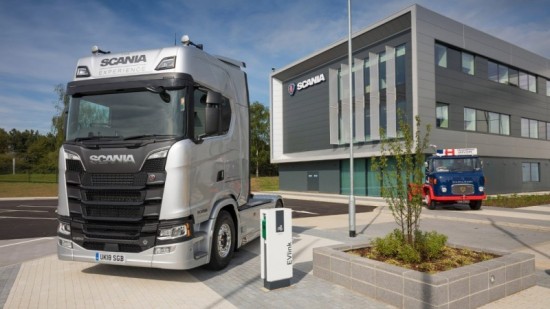
Scania (Great Britain) Limited's new UK Support Centre has been inaugurated by His Excellency Torbjörn Sohlström, the Ambassador of Sweden to the UK. The event, which was attended by Scania's staff and approximately 40 transport industry guests and local dignitaries, took place at the Delaware Drive, Tongwell, Milton Keynes premises on Wednesday 22 May 2019.
Speaking at the event, Scania (Great Britain) Limited's Managing Director Martin Hay said, "Scania came to Milton Keynes in 1981 and today is one of the largest employers in the area. In addition to growing sales of our trucks, buses, coaches and engines over the years, we have also developed a host of associated services; truck rental, used sales, finance, connected services, driver training and development, and so on. All of this requires extensive dealer and customer support, which is why we are referring to our new premises as our UK Support Centre rather than our headquarters."
Future proofed and sustainable
The premises, which occupy a site of almost eight acres in size, have been constructed with the future and sustainability in mind. As such, state-of-the-art technology is employed throughout and the buildings have been designed to have as low an impact on their surroundings as possible. The new main building provides 6,200 square metres of space over three storeys, and there is a separate Facilities building and parking for just under 300 cars, including disabled bays and electric charging points.
The design approach has been entirely focused on Scania's ethos of collaboration and interaction. The layout of the main building is extremely modern and has been designed to encourage a cross-flow of interaction with numerous break-out areas.
In terms of environmental features, Scania has taken a 'fabric first' approach to energy, which means the building envelope has been designed for efficiency and the interior designed to require less energy – which has been achieved through high levels of insulation and low energy fittings throughout.
Ten percent of the site's energy comes from renewable sources; there are 385 square metres of photovoltaic panels on the roof. These, together with air source heat pumps, which transfer heat from outside the building to the inside, will reduce carbon dioxide emissions by a minimum of ten percent.
Water usage is expected to reduce by at least 25 percent through efficient sanitaryware, showers, washing machines, dishwashers and flow-restricted taps. The site is also equipped with water butts to recycle rainwater for the landscaping.
Other key sustainability and environmental features of the site include:
- Building life cycle and running costs have been designed to be as low as possible. To achieve this, the building achieves better than required ‘U’ values (heat loss) and energy demand.
- The building achieves better than maximum air leakage – air seal detailing keeps leakage as low as possible and better than required by Building Regulations.
- Wherever possible, local materials have been specified and sourced.
- Local people were involved with the construction – Scania (Great Britain) Limited employed Kier, a locally based contractor, which has a policy of using local staff and labour where possible.
- Glazing with low G-value (solar gain) reduces energy required to mechanically cool the premises.
- Daylight maximisation: High light transmittance values mean less artificial lighting is required to achieve the required lighting levels, thereby reducing electricity usage.
- Rooms with windows include daylight linked lighting controls and PIR control throughout to switch off lighting when not occupied.
- Advanced HVAC (heating, ventilation and air conditioning) equipment used throughout to maximise seasonal efficiency.
- Comprehensive metering connected to an energy management tool reports on any excess usage.
